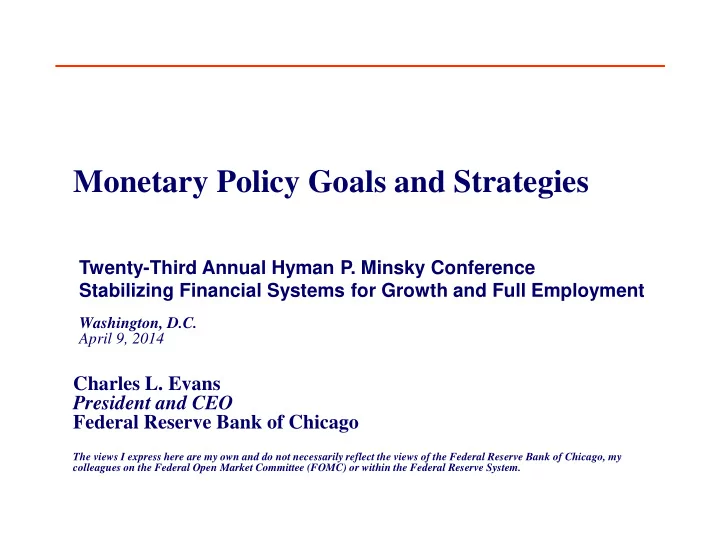

Monetary Policy Goals and Strategies Twenty-Third Annual Hyman P. Minsky Conference Stabilizing Financial Systems for Growth and Full Employment Washington, D.C. April 9, 2014 Charles L. Evans President and CEO Federal Reserve Bank of Chicago The views I express here are my own and do not necessarily reflect the views of the Federal Reserve Bank of Chicago, my colleagues on the Federal Open Market Committee (FOMC) or within the Federal Reserve System.
1. Three Big Events in Fed History The Great Depression (1929-1938) “Inept monetary policy” failed to adequately combat credit contraction, deflation, and depression The Great Inflation (1965-1980) Monetary policy failed to recognize structural changes and expectational dynamics that led to double-digit inflation The Treasury Accord (1951) An example highlighting the importance of central bank independence
2. Long-Run Strategy for Monetary Policy (January 2012, reaffirmed thereafter every January) π * = 2% PCE inflation U t * ~ 5.2% - 5.6% time-varying Central tendency of SEP longer-run normal rate Balanced approach to reducing deviations of inflation and employment from long-run objectives
3. Bull’s-Eye Accountability for Fed’s Dual Mandate Loss Function L = ( π - π *) 2 + 0.25 (y – y*) 2 (percent) L = ( π - 2) 2 + (u – u n ) 2 π = 5.6% Inflation u = 9% π * 2015 2016 2014 September 2011 2012 2013 Unemployment u n *2014 – 2016 values are FOMC participants’ Summary of Economic Projections midpoints, March 19, 2014.
4. Policy Rate Constrained by Zero Lower Bound Fed Funds Rate (percent) 12 8 History 4 Q4-2013 0 Taylor (1999) Rule based on inflation and CBO output gap -4 -8 1989 '93 '97 '01 '05 '09 '13 In the period prior to the explicit inflation target set by the FOMC, the Taylor Rule was constructed using long-run inflation forecasts from the Survey of Professional Forecasters , or when available, from the Summary of Economic Projections .
Recommend
More recommend